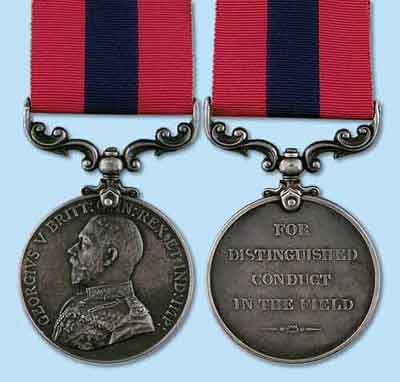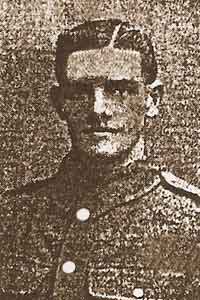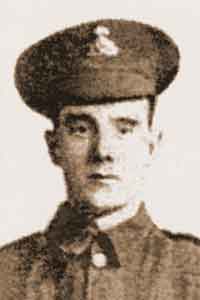Denton Recipients of the
Distinguished Conduct Medal (DCM),
1914-1919
The Distinguished Conduct Medal (DCM) was instituted by Royal Warrant on the 4 December 1854, during the Crimean War, as an award to Warrant Officers, Non-Commissioned Officers and men for ‘distinguished, gallant and good conduct in the field’. For all ranks below commissioned officers, it was the second highest award for gallantry in action after the Victoria Cross, and the other ranks' equivalent of the Distinguished Service Order (DSO), which was awarded to commissioned officers for bravery.

11th Battalion, Cheshire Regiment
For conspicuous gallantry and devotion to duty
Citation
This N.C.O., in a counter-attack, organised the men round him and pushed forward until, his position becoming untenable, he was ordered to withdraw, which he did, personally carrying two wounded men in under heavy fire. Later, when all the officers had become casualties, he took command and held the position until relieved. His example was excellent, and he acted with coolness and determination.
Reference: The London Gazette, Supplement 30879, Page 10270, 30 August 1918.
John Bertenshaw served in the 11th (Service) Battalion of the Cheshire Regiment.
He survived the war to be demobilised. He was resident on Princess Avenue, Denton.
Cheshire Regiment
For conspicuous gallantry and devotion to duty
Citation
During the capture of an enemy position the first two waves of the attack were held up by a strong point. This N.C.O. initiated a flank attack and successfully put the strong point out of action, thus enabling our advance to proceed. His coolness and dash were most marked, and set a splendid example to his men.
Reference: The London Gazette, Supplement 30495, Page 1292, 25 January 1918.
Ernest Boon served in the 10th (Service) Battalion of the Cheshire Regiment. Subsequently, he was promoted to the rank of Serjeant and the Citation reads
as though he held this rank at the time of his gallantry. He was killed in action on the 16 April 1918, aged 30 years, and he is commemorated on the Tyne Cot Memorial, Belgium, Panel 61 to 63.
He was resident on Wilton Street, Denton.
Royal Engineers
For conspicuous gallantry and devotion to duty as dispatch rider
Citation
When the enemy attacked and entered a village, he volunteered to try and get through with an urgent message. He rushed through the enemy, who were holding the cross roads, although machine guns were turned on him. He was then chased down the road by two enemy aeroplanes, but got away and delivered his message. He showed magnificent courage and initiative.
Reference: The London Gazette, Supplement 30664, Page 5295, 30 April 1918.
He survived the war to be demobilised. He was resident on Stockport Road, Denton.
“B” Company, 1st Battalion, Cheshire Regiment
Citation
For conspicuous gallantry near Ypres in continuing to work his machine gun after the trenches on his left flank had been evacuated, thereby securing the general line from being broken. Has shown marked ability in machine-gun work throughout the campaign.
Reference: The Edinburgh Gazette, Issue 12791, Page 497, 6 April 1915.
A German offensive in November 1914 drove a gap in the trenches on the left flank of the 1st Battalion. George Downs and his machine gunners strove to prevent the enemy from pouring through but
one after another his men were struck down until he was left alone.
Company Quartermaster Serjeant (Warrant Officer Class 2) George Downs was also awarded a Clasp to his 1914 Star. A bar clasp inscribed '5 Aug. to 22 Nov. 1914' was awarded to all those who qualified for the 1914 Star and who served under fire. Holders of the 1914 Star were permitted to wear a small silver rosette on their ribbon when the decoration itself was not worn.
On Saturday, 25 November 1916 the Chairman of Denton Urban District Council presented Company Quartermaster Serjeant George Downs with a gold hunter watch. The presentation took place on a platform erected in the Market Place. At the same ceremony Albert Hill VC was presented with a gold watch and a framed photo of himself by the Chairman for his gallantry at Delville Wood on Thursday, 20 July 1916 during the Battle of the Somme (1 July 1916 to 18 November 1916).
The parents of George Downs were resident on Elizabeth Street, Denton.

123rd Battery, Royal Garrison Artillery
For conspicuous gallantry and devotion to duty
during a German attack on Hooge on 30th July 1915
Citation
Corporal Eldridge and two comrades belonged to one detachment, all the other men of which were either killed or wounded by very heavy shell fire from three directions, but they kept their gun in action and maintained its rate of fire, till finally Corporal Eldridge was wounded and rendered helpless.
Reference: The Edinburgh Gazette, Issue 12854, Page 1443, 21 September 1915.
Subsequently, Harold ELDRIDGE was promoted to the rank of Battery Serjeant Major (Warrant Officer Class 2) and he was also awarded the Croix de Guerre (Belgium) for bravery on the battlefield.
He survived the war and he was a Denton resident.
32nd Battalion, Machine Gun Corps
For great gallantry and initiative
near Joncourt* on 2nd October 1918
Citation
The enemy suddenly opened on the section with machine guns, the officer became a casualty as well as the other N.C.O.s, and he took command.
The section was in a most exposed position when he took charge, but he gradually got all the guns safely back to a more sheltered place and was able to materially assist in beating off a counter-attack.
He continued in charge of the section through the day, setting a fine example of cool courage and ability.
Reference: The London Gazette, Supplement 31668, Page 14851, 28 November 1919.
Thomas Howe enlisted in the army on the 26 October 1914 and initially he served with the Lancashire Fusiliers as 9225 Private Thomas Howe. He then transferred to the Machine Gun Corps and after further training he entered the Theatre of War in France and Flanders (Western Front).
At some stage in the action for which he was awarded the DCM it is understood that he carried his wounded officer to safety and while doing so the officer was wounded again. Although he was gassed twice and wounded in the thigh during the war, he survived to be demobilised.
Thomas Howe was born at Stockport on the 12 July 1889 to Ezra Howe and Frances Done who were married at Hayfield, Derbyshire, in 1880. He married Hannah ‘Ann’ Hadfield a St Thomas’s Church, Hyde, in 1910 and in 1911 he was resident with his wife and son, Stanley (4 months), on Queen Street, Hyde, Cheshire, employed as a coal miner. Later the family moved to Gibraltar Lane, Haughton Green, Denton. Prior to the war he was employed at the Bredbury Colliery Co Ltd on Lingard Lane, Bredbury. By 1939 he was employed as a permanent way labourer.

148008 Lance Corporal Thomas Howe DCM.
Credit: L Quirk.
Thomas Howe’s son, Stanley Howe, was awarded the DCM in 1945 and he received his medal from King George VI at Buckingham Palace in 1946. 3453673 Sergeant (Acting Company Sergeant Major (Acting Warrant Officer Class II)) served with the Durham Light Infantry and his home residence was on Edna Street, Hyde. Reference: The London Gazette, Supplement 36961, Page 1178, 27 February 1945.
Manchester Regiment
For conspicuous gallantry and devotion to duty
during a raid on the enemy's trenches
Citation
When an enemy machine gun opened fire on the right of the raiding party, he rushed it with an N.C.O. and another man, killed the detachment and captured the gun. His prompt and courageous action was of the greatest assistance to the raiding party.
Reference: The London Gazette, Supplement 30664, Page 5302, 30 April 1918.
Archibald Latham served in the 1/9th Battalion, Manchester Regiment. Although gassed and wounded, he survived the war to be demobilised. He was born in Hockley, Warwickshire and was resident on Stockport Road, Denton.
Manchester Regiment
For conspicuous gallantry and devotion to duty
during a raid on the enemy's trenches
Citation
When an enemy machine gun opened fire on the right of the raiding party he rushed it with two men, killed the detachment, and captured the gun. His prompt and courageous action was of the greatest assistance to the raiding party.
Reference: The London Gazette, Supplement 30664, Page 5311, 30 April 1918.
Frank Thickett served in “A” Company, 1/9th Battalion, Manchester Regiment. The 9th (Territorial) Battalion was raised in 1908.
He was killed in action on the 21 March 1918, aged 27 years, and he is commemorated on the Pozieres Memorial, France, Panel 64 to 67. He was resident on Thornleys Road, Haughton.
